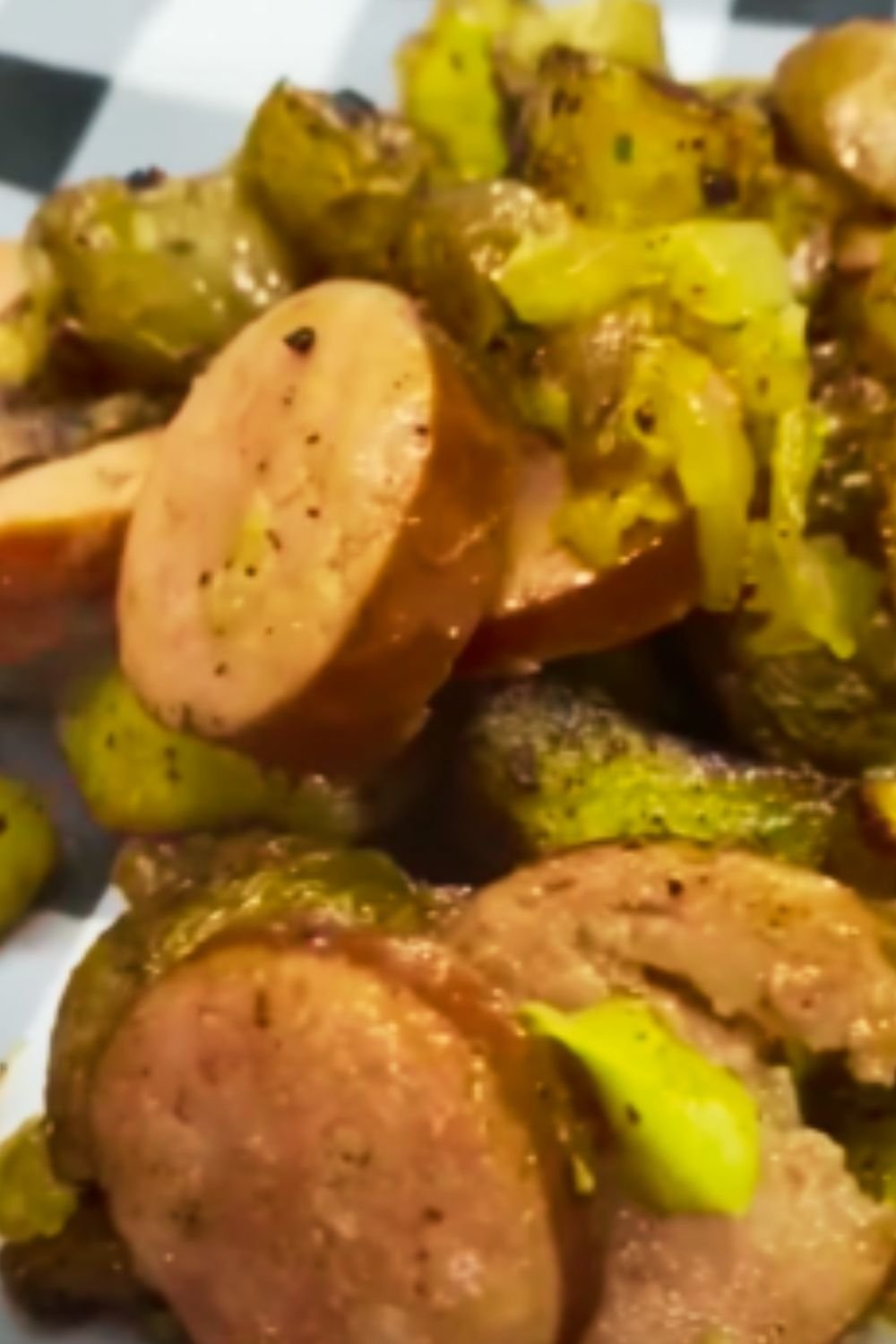There’s something deeply satisfying about walking into your home after a long day and being greeted by the tantalizing aroma of dinner already prepared. That’s the magic of slow cooking, and today I’m sharing one of my absolute favorite comfort food recipes: Slow Cooker Sauerkraut and Kielbasa. This dish brings together the smoky richness of kielbasa sausage with the tangy complexity of sauerkraut, all melded together in a slow simmer that develops incredible depth of flavor.
As someone who grew up in a household where Eastern European cuisine made regular appearances on our dinner table, I’ve spent years perfecting this recipe. The beauty of this dish lies in its simplicity—just a handful of ingredients that transform into something truly special when given time to develop together.
Whether you’re feeding a hungry family or meal prepping for the week ahead, this Slow Cooker Sauerkraut and Kielbasa recipe delivers big on flavor while requiring minimal effort. Let me walk you through creating this hearty, soul-warming meal that’s perfect for cool weather but delicious year-round.
Ingredients You’ll Need
For this classic comfort dish, you won’t need to hunt down any exotic ingredients. Most of these items are pantry and refrigerator staples that might already be waiting in your kitchen:
- 2 pounds kielbasa sausage, sliced into 1-inch pieces
- 32 ounces sauerkraut (about 4 cups), drained but not rinsed
- 3 medium russet potatoes, peeled and cubed into 1-inch pieces
- 1 large yellow onion, diced
- 2 Granny Smith apples, peeled, cored and diced
- 2 tablespoons brown sugar
- 1 tablespoon caraway seeds
- 1 teaspoon paprika (smoked paprika adds extra depth)
- ½ teaspoon freshly ground black pepper
- 1 cup chicken broth or stock (low sodium preferred)
- 2 bay leaves
- 2 tablespoons Dijon mustard
- 3 cloves garlic, minced
Kitchen Equipment Needed
One of the joys of slow cooker recipes is their simplicity, and this extends to the equipment needed:
- 6-quart slow cooker (or larger)
- Cutting board
- Sharp knife
- Measuring cups and spoons
- Wooden spoon for mixing
- Colander for draining sauerkraut
Understanding Your Ingredients
Before we dive into preparation, let’s take a moment to understand the key players in this dish:
Kielbasa : A Polish smoked sausage traditionally made from pork, though varieties using beef, turkey, or combinations are now common. Its smoky flavor forms the foundation of our dish. You can use any variety you prefer—traditional pork kielbasa, turkey kielbasa for a lighter option, or even beef kielbasa.
Sauerkraut : Fermented cabbage that brings tartness and complexity. The fermentation process creates beneficial probiotics and a distinctive tangy flavor that balances perfectly with the rich kielbasa. Quality matters here—refrigerated sauerkraut generally has better flavor than shelf-stable varieties.
Caraway Seeds : These small seeds add a distinctive aromatic quality with notes of anise, citrus, and pepper that complement sauerkraut beautifully. Don’t skip this ingredient—it’s traditional and adds authentic flavor.
Apples : The secret ingredient that adds natural sweetness to balance the tart sauerkraut. Granny Smith apples hold their shape well during slow cooking while providing just the right amount of tartness.
Preparation Steps

- Prepare the kielbasa: Slice the kielbasa into 1-inch thick rounds. If you prefer smaller pieces, you can halve or quarter the rounds.
- Drain the sauerkraut: Place the sauerkraut in a colander and press gently to remove excess liquid. Don’t rinse it—we want to keep some of that tangy flavor.
- Prep the vegetables and apples: Peel and cube the potatoes into 1-inch pieces. Dice the onion. Peel, core, and dice the apples into roughly ½-inch cubes.
- Layer ingredients in the slow cooker: Start by placing the diced potatoes at the bottom (they take longest to cook), followed by the drained sauerkraut, diced apples, and onions.
- Add seasonings: Sprinkle the brown sugar, caraway seeds, paprika, black pepper, minced garlic, and Dijon mustard over the vegetables.
- Add the kielbasa: Arrange the sliced kielbasa over the top of the vegetable mixture.
- Pour in liquid: Add the chicken broth and tuck in the bay leaves.
- Cover and cook: Place the lid on your slow cooker and set to Low for 6-7 hours or High for 3-4 hours.
Cooking Tips for Perfect Results
After making this dish countless times, I’ve gathered some insights that make a significant difference in the final result:
- Don’t stir immediately: Resist the urge to stir everything together at the beginning. Layering the ingredients allows the potatoes to cook properly at the bottom near the heat source, while the kielbasa flavors everything as it cooks.
- Mid-cooking stir: About halfway through cooking time, gently stir the ingredients to distribute flavors, then replace the lid quickly to maintain heat.
- Thickness control: If you find too much liquid at the end of cooking, remove the lid for the last 30 minutes of cooking time to allow some evaporation. Conversely, if it seems too dry, add a little more broth.
- Sauerkraut selection matters: If possible, choose refrigerated sauerkraut over canned for better flavor. Some brands are more acidic than others, so adjust the brown sugar accordingly.
- Kielbasa varieties: While traditional pork kielbasa is classic, don’t hesitate to try turkey or beef varieties for different flavor profiles and nutritional benefits.
Nutritional Information
Understanding the nutritional content of what we eat helps us make informed choices. Here’s a breakdown of the approximate nutritional values per serving (based on 8 servings):
| Nutrient | Amount per Serving |
|---|---|
| Calories | 385 |
| Protein | 18g |
| Fat | 24g |
| Saturated Fat | 8g |
| Carbohydrates | 25g |
| Fiber | 5g |
| Sugar | 8g |
| Sodium | 1,250mg |
| Potassium | 820mg |
| Vitamin C | 35% DV |
| Iron | 15% DV |
Note: These values will vary based on the specific brands and types of ingredients used, particularly the kielbasa variety.
Serving Suggestions

This hearty dish stands perfectly well on its own, but I love to serve it with complementary sides that enhance the meal:
- Thick slices of rye bread or pumpernickel with butter
- A dollop of whole grain mustard on the side
- Braised red cabbage for color contrast and flavor complement
- A simple green salad with a light vinaigrette to cut through the richness
- Applesauce (especially homemade) as a sweet counterpoint
- Pickled beets for additional Eastern European flair
- Fresh dill or parsley sprinkled on top for color and fresh flavor
Make-Ahead and Storage Options
One of the greatest advantages of this dish is how well it stores and even improves with time:
- Make-ahead: This dish actually tastes better the next day as the flavors continue to meld. Consider making it a day before you plan to serve it.
- Refrigeration: Store leftovers in airtight containers in the refrigerator for up to 4 days.
- Freezing: This dish freezes beautifully. Portion into freezer-safe containers and freeze for up to 3 months. Thaw overnight in the refrigerator before reheating.
- Reheating: Warm gently in a covered saucepan over medium-low heat, stirring occasionally. Add a splash of chicken broth if it seems dry. Microwave on medium power in 1-minute intervals, stirring between, until heated through.
Variations to Try
The basic recipe is wonderful as is, but don’t be afraid to put your own spin on it:
- Add sliced mushrooms for an earthy dimension
- Incorporate bell peppers (red or green) for color and sweetness
- Stir in a cup of rinsed sauerkraut at the very end of cooking for more texture contrast
- Use different sausages like smoked bratwurst or even chorizo for a fusion twist
- Add a splash of apple cider instead of some of the broth for more apple flavor
- Include a tablespoon of tomato paste for depth and color
- Sprinkle with caraway-infused sour cream before serving for a creamy finish
Troubleshooting Common Issues
Even experienced cooks sometimes encounter challenges. Here are solutions to common problems:
- Too sour: Add an additional tablespoon of brown sugar or a drizzle of honey.
- Too sweet: Balance with a tablespoon of apple cider vinegar or more Dijon mustard.
- Potatoes not tender: They may need more time. Next time, cut them smaller or partially cook them before adding to the slow cooker.
- Too watery: Remove the lid for the last 30-45 minutes of cooking, or thicken with a cornstarch slurry (1 tablespoon cornstarch mixed with 2 tablespoons cold water).
- Too dry: Add additional chicken broth or even a splash of apple juice.
The Complete Meal Prep Timeline
For those who like to plan ahead, here’s a timeline for preparing this meal efficiently:
| Time Before Serving | Task |
|---|---|
| 1 day before | Purchase all ingredients, ensuring freshness |
| Morning of (or 6-7 hours before dinner) | Prep all ingredients and start slow cooker on Low |
| 3-4 hours before dinner | Alternative start time using High setting |
| 30 minutes before serving | Check consistency, adjust seasonings, prepare any side dishes |
| 15 minutes before serving | Remove bay leaves, give a final gentle stir, allow to rest briefly |
| Serving time | Garnish with fresh herbs if desired and serve hot |

Why This Recipe Works
There’s food science behind why this combination is so delicious:
The slow cooking process allows the flavors to meld beautifully while breaking down the tough fibers in the sauerkraut, mellowing its sharpness. Meanwhile, the fat from the kielbasa infuses everything with rich smoky flavor.
The natural sweetness from the apples and brown sugar balances the acidity of the sauerkraut through a process called contrast integration, where opposing flavors enhance rather than compete with each other.
The caraway seeds contribute aromatic compounds called terpenes that specifically complement the flavor compounds in fermented cabbage, creating a harmonious flavor profile recognized in Eastern European cuisine for centuries.
Frequently Asked Questions
Q: Can I use fresh cabbage instead of sauerkraut?
A: While you can use fresh cabbage, it won’t provide the same tangy flavor that makes this dish special. If you do use fresh cabbage, add 2-3 tablespoons of apple cider vinegar to mimic some of that tanginess.
Q: Is it necessary to brown the kielbasa before adding it to the slow cooker?
A: Browning the kielbasa adds extra flavor through the Maillard reaction, but it’s not essential. If you have the time, browning the slices in a skillet for 2-3 minutes per side adds wonderful depth, but the recipe works perfectly well without this step.
Q: My family doesn’t like sauerkraut. Can I reduce the amount?
A: Absolutely. Start with half the amount and supplement with more diced cabbage or potatoes. The long cooking time will mellow the sauerkraut’s tanginess considerably, so even sauerkraut skeptics might enjoy this dish.
Q: Can I make this in an Instant Pot instead?
A: Yes! Use the sauté function to brown the kielbasa first (optional), then add all ingredients and cook on high pressure for 15 minutes with a 10-minute natural release. The result will be similar, though the slow cooker version develops slightly more depth of flavor.
Q: How can I make this recipe lower in sodium?
A: Rinse the sauerkraut well before using (though this will reduce some flavor), use low-sodium chicken broth, and look for reduced-sodium kielbasa. You can also increase the proportion of potatoes and apples to sausage.
Q: Can I add beer to this recipe?
A: A non-alcoholic apple cider makes an excellent liquid addition that complements the flavors perfectly.
Q: Is this recipe gluten-free?
A: Most kielbasa is gluten-free, but always check the packaging to be sure. All other ingredients in the basic recipe are naturally gluten-free, making this a great option for those with gluten sensitivities.
Final Thoughts
This Slow Cooker Sauerkraut and Kielbasa recipe represents comfort food at its finest—simple ingredients transformed through gentle cooking into something greater than the sum of its parts. What I love most about this dish is how it connects me to culinary traditions that have sustained generations while still fitting perfectly into our busy modern lives.
There’s something deeply satisfying about preparing a meal that requires minimal hands-on time yet delivers such rich, complex flavors. I find myself returning to this recipe again and again throughout the year, but especially during the cooler months when its heartiness feels particularly welcome.
I encourage you to make this recipe your own. Perhaps you’ll add a family twist that becomes your signature version, or maybe you’ll discover the perfect side dish pairing that elevates it further. However you serve it, I’m confident this humble yet delicious meal will earn a place in your regular rotation, just as it has in mine.
Happy cooking, and even happier eating!


